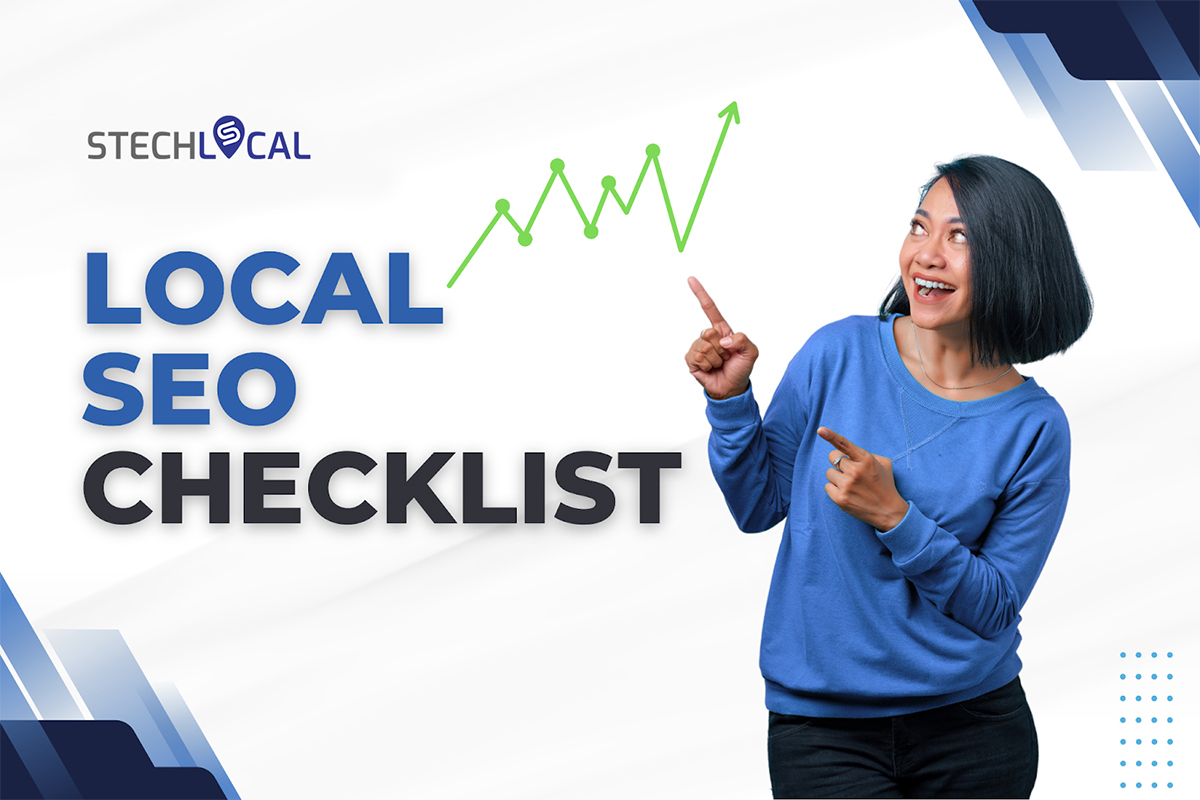What Is Local SEO? A Beginner’s Guide for 2025
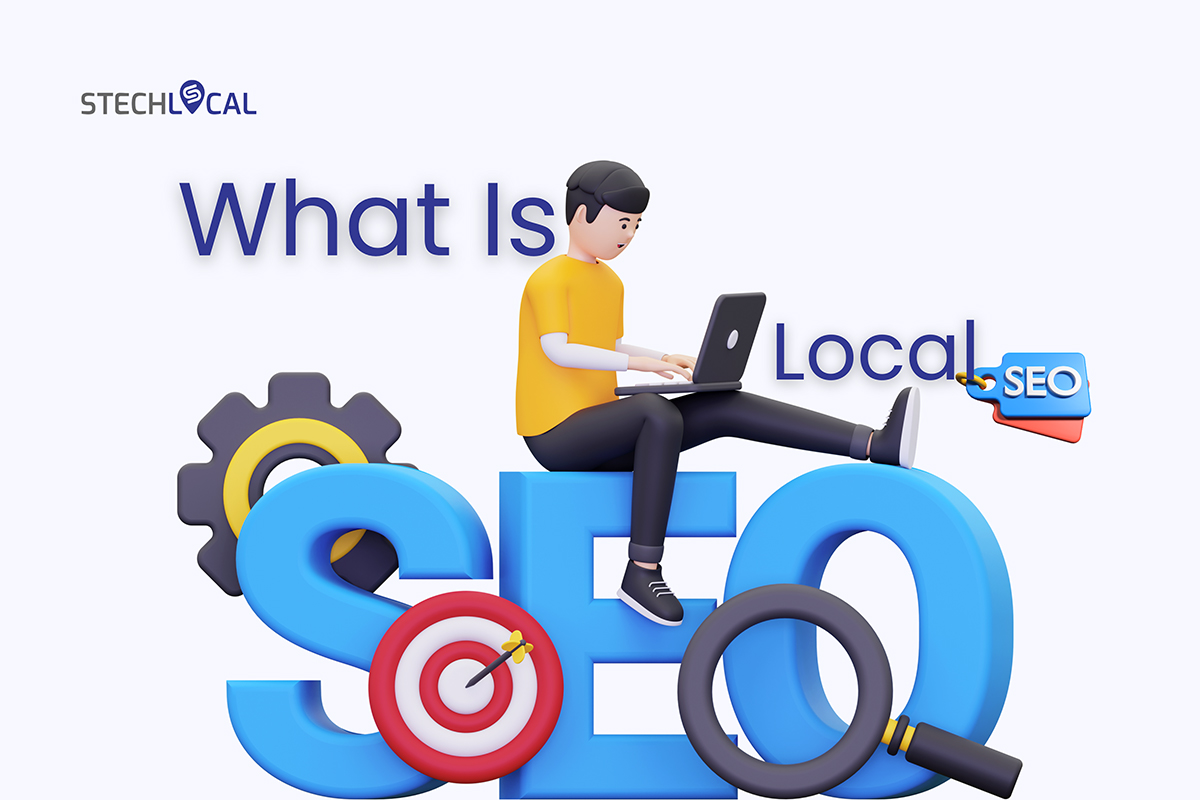
In 2025, local searches like “best bakery near me” or “plumber in Chicago” will drive real results for businesses. Local SEO helps your business appear in these high-intent searches by optimising your online presence for a specific geographic area.
So, what is local SEO? This detailed guide will help you understand its fundamentals, why it is essential, and how to optimize your Google Business Profile (GBP) as a beginner.
What Is Local SEO?
Local SEO (Local Search Engine Optimisation) allows your business to be visible in search results when people look for products or services nearby, especially on Google.
It works like regular SEO, which helps websites appear in free search results (Search Engine Results Page). Local SEO aims to promote your business within a specific region, such as your neighborhood, city, or town.
Local SEO is crucial for small and service-based businesses that depend on foot traffic, phone calls, or local leads. It helps ensure your business shows up where and when local customers are actively searching.
According to Google, 76% of local mobile searchers visit a business within a day, making local SEO critical for foot traffic and conversions.

Why Is Local SEO Important?
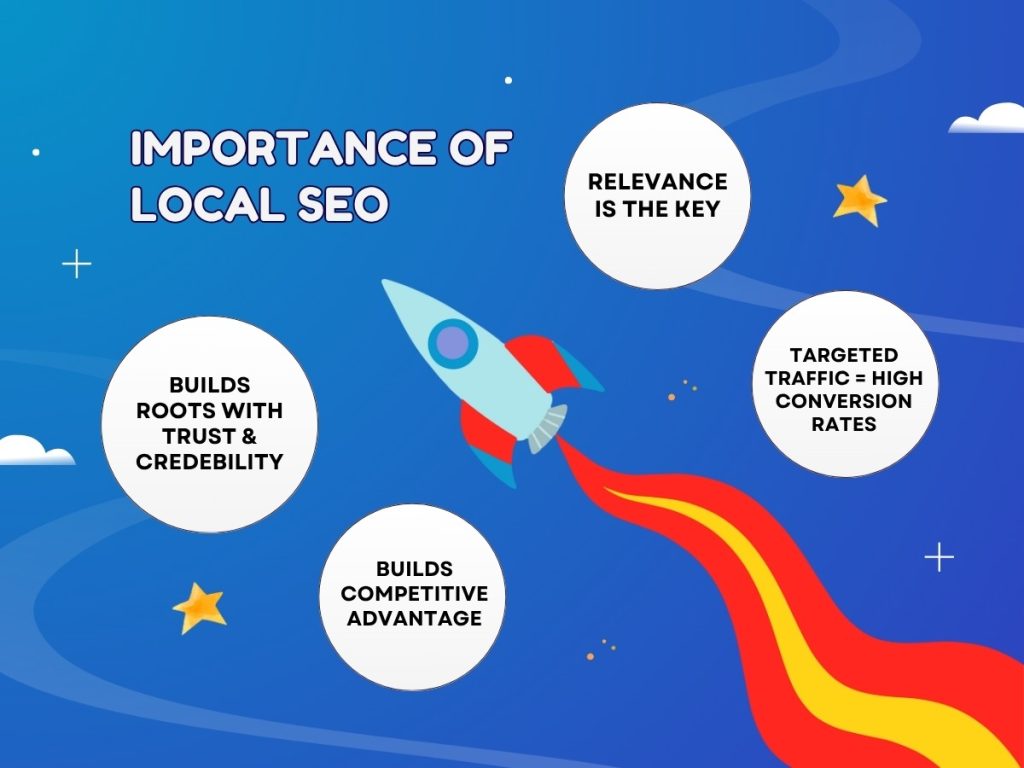
- Relevance: Local SEO ensures your business appears to people looking for your products or services in your area. This means you’re not just attracting traffic, you’re reaching the right audience at the right time.
- Targeted Traffic and High Conversion Rates: Local searches often come from users with strong intent. For example, someone searching for “best pizza near me” is likely ready to purchase or visit a store. Local SEO makes you more likely to attract ready-to-act customers, leading to higher conversion rates.
- Building Trust and Credibility: A well-optimized Google Business Profile, positive reviews, accurate contact information, and consistent local citations build trust with potential customers. When your business shows up prominently in local results, it signals credibility and reliability.
- Competitive Advantage: Many small businesses still overlook local SEO. By investing in it, you can stand out from competitors in your area, especially those not taking advantage of local search optimization. This gives your business a strong local edge and helps you attract more customers.
How Does Local SEO Work?
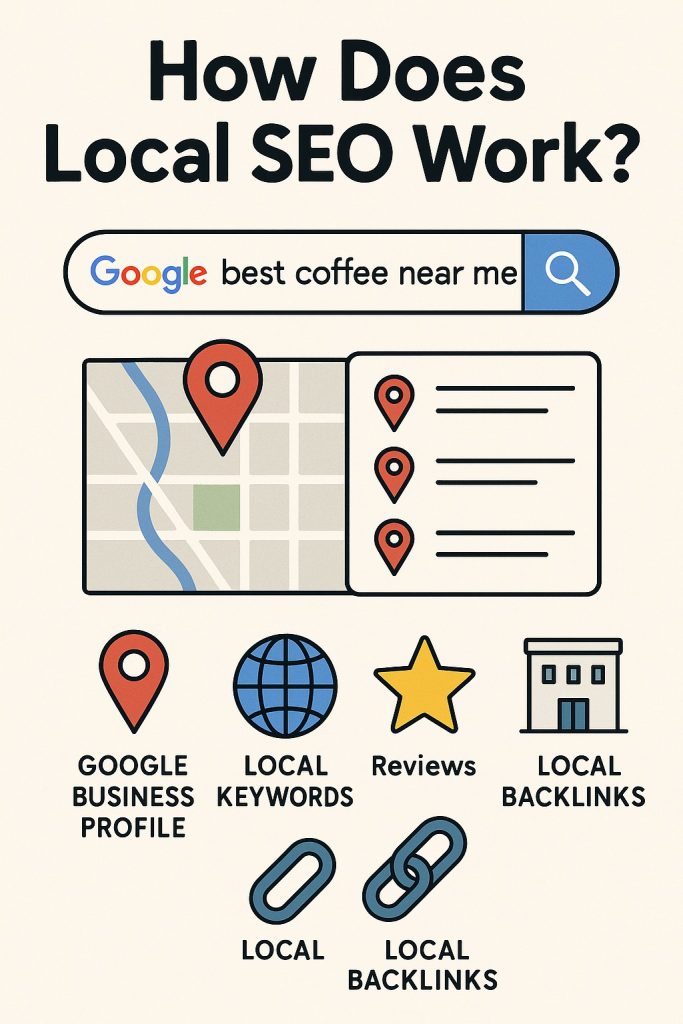
Local SEO works by helping Google understand your business’s location, services, and reputation, which boosts your chances of showing up in local searches, especially on Google Maps and the local pack.
When ranking businesses in the Local Pack and Google Maps, Google looks at:
- Relevance: How your business matches what the user is searching for
- Distance: How close your business is to the user’s location
- Prominence: How well-known, reviewed, and trusted your business appears online
When ranking web pages in regular search results, Google considers:
- Relevance: How closely your website content matches the user’s query
- Quality: Whether your content is helpful, accurate, and trustworthy
- Usability: How well your website performs, especially on mobile devices and loading speed
Things To Consider in Local SEO
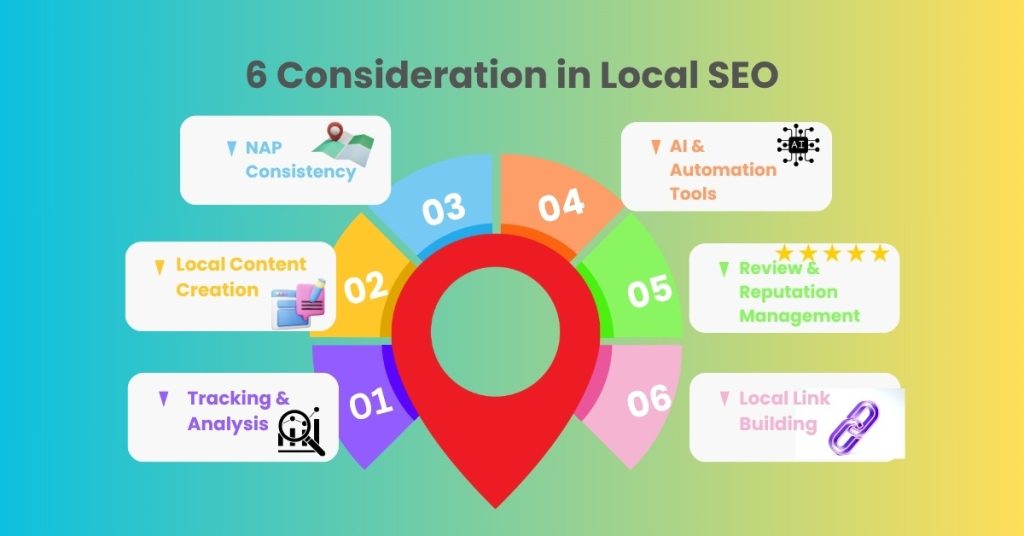
- Consistent NAP Information: Ensure your business name, address, and phone number are accurate across all directories and listings.
- Localized Content Creation: Develop location-specific blogs, landing pages, and service pages to attract nearby users searching with local intent.
- Tracking and Analytics: Monitor performance using GA4, Search Console, and tools to track keyword rankings, traffic, and lead sources.
- AI and Automation Tools: Use AI-driven features like auto-replies, smart messaging, chatbots, and predictive insights to improve engagement and efficiency.
- Review and Reputation Management: Encourage satisfied customers to leave reviews, respond promptly to feedback, and manage your online reputation proactively.
- Local Link Building: Gain backlinks from nearby organizations, sponsorships, local blogs, and business directories to build authority.
Key Local SEO Strategies for Beginners in 2025
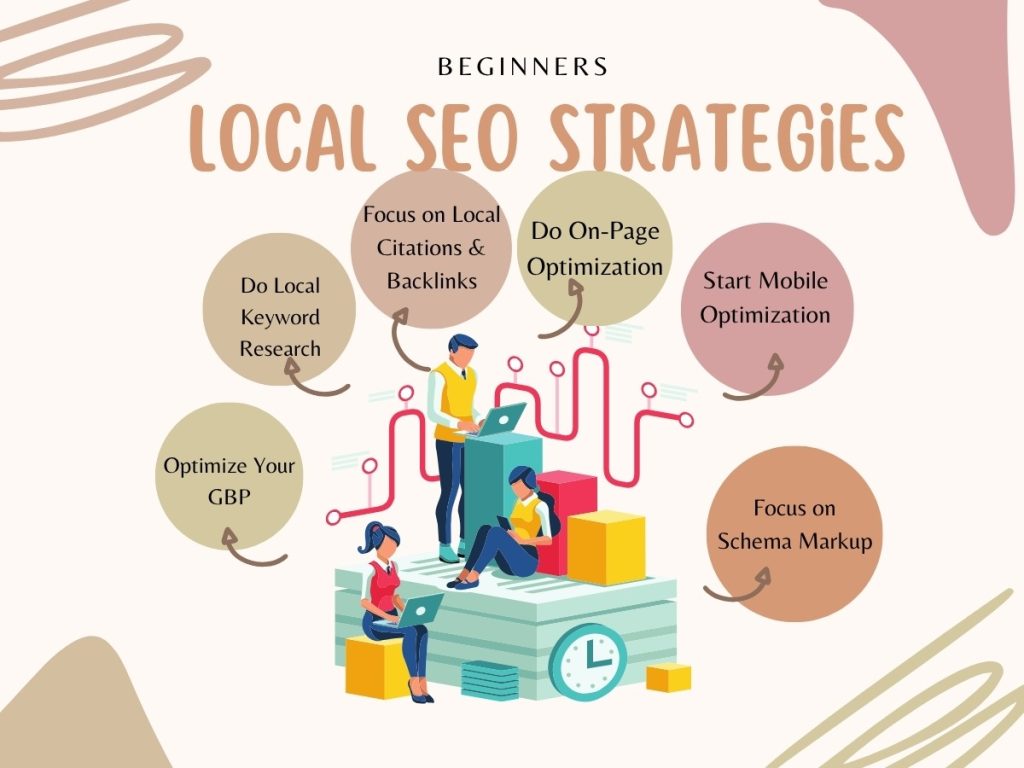
1: Optimize Your Google Business Profile (GBP)
Enhancing your Google Business Profile (GBP) is a fundamental step for beginners aiming to succeed with local SEO in 2025.
Your GBP is often the first thing customers see when they search for your business on Google or Maps.
Step-by-Steps for Optimising Your Google Business Profile (GBP):
- Claim and verify your business by visiting the official Google Business Profile. Once verified, ensure your profile is completely filled out with accurate and consistent information.
- Include your address, business name, phone number, website URL, business category, operating hours (including special holiday hours), and service area if you visit customers at their location.
- Uploading high-quality photos and videos helps your profile attract more attention and engagement. Include images of your storefront, interior, products, staff, and even short video clips introducing your services.
- Don’t overlook the business description section; use this space to describe your offerings and what sets you apart, ideally incorporating local keywords naturally.
- Encourage happy customers to leave reviews and respond to all feedback to build trust and boost credibility.
- Use Google Posts to share updates, special promotions, or events directly on your profile. These posts appear in your business listing and can help increase engagement.
- Keep your profile updated regularly and monitor its performance through Google Business Insights, which provides data on how customers find and interact with your listing.
An optimized Google Business Profile looks like:
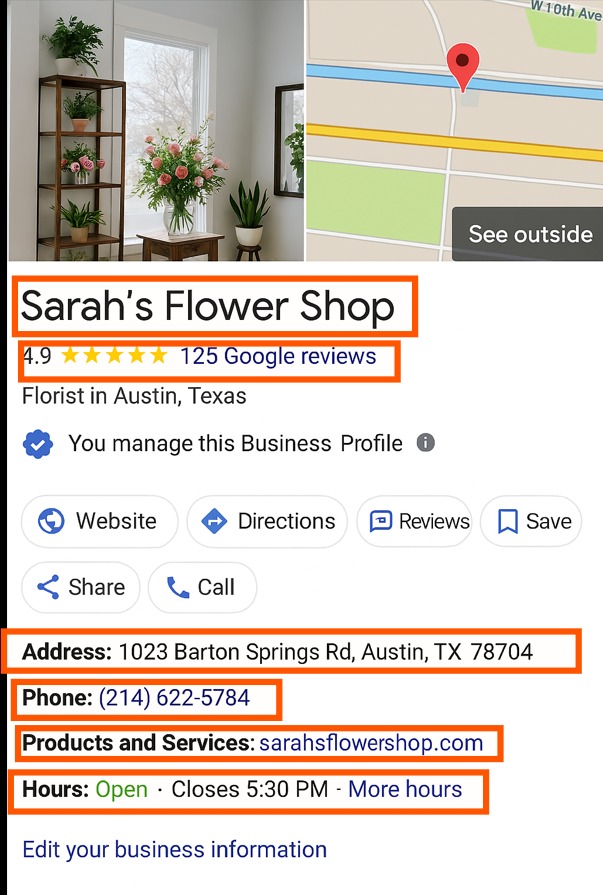
2: Local Keyword Research
Local SEO keyword research is the process of identifying keywords used by people in their local areas when searching for products, services, or amenities.
Local businesses can benefit from optimizing their pages for local keywords, increasing visibility in search engine results pages, attracting more organic traffic, increasing foot traffic and inquiries, and boosting sales.
Focus on keywords that include your city, neighborhood, or region, as well as common phrases like “near me,” “best,” or “open now.” For example, instead of using “dentist,” a local keyword would be “family dentist in Chicago.”
Use tools like Ubersuggest, Google Keyword Planner, or Ahrefs to find effective local keywords. Check Google’s autocomplete suggestions as you type a service. Look at “People also ask” and “Related searches” at the bottom of search result pages.
Once you’ve found relevant local keywords, use them naturally in:
- Your website content (homepage, service pages, blog posts)
- Google Business Profile description and posts
- Meta titles, descriptions, and image alt tags
- Online listings and directories
3: Local Citations and Backlinks
Local citations and backlinks help boost your business’s credibility and visibility in local search results.
A local citation refers to any online listing that includes your business’s name, address, and phone number (NAP). These usually appear in directories like Yelp, Justdial, Yellow Pages, Facebook, Bing Places, and many industry-specific or local sites.
Consistent and accurate citations across multiple platforms help Google confirm that your business is legitimate and active in your area.
On the other hand, backlinks are links from other websites pointing to your site. Local backlinks from trusted sources, such as blogs, news outlets, business directories, and community organisations, show Google that your website is credible and locally relevant.
Emphasise quality over quantity by securing backlinks from trusted, authoritative sources within your local area. To gain local backlinks, collaborate with local influencers or media and write guest posts for community or business websites.
4: On-Page Optimization
On-page optimization involves refining the content and layout of your website to boost visibility in local searches, helping search engines identify your services and location for better rankings.
Start by optimizing your homepage and main service pages with relevant local keywords. For example, rather than just “plumbing services,” use “plumbing services in Chicago” or “emergency plumber near Brooklyn.”
Place these keywords naturally in your page titles, meta descriptions, headers (H1, H2), URL slugs, and image alt texts.
Set a dedicated contact page with your complete name, address, phone number (NAP), business hours, an embedded Google Map for directions, and a simple contact form.
If you have multiple locations, build individual location landing pages for each area you serve. These pages should contain localized content, specific contact info, and keywords related to that region.
Furthermore, create valuable, locally relevant content, such as blog posts about local events, customer stories, or area-specific tips. This improves engagement and increases your chances of ranking for long-tail local searches.
Proper on-page optimization strengthens your website’s SEO foundation and helps search engines connect your business with nearby customers searching for your services.
4: Encourage Online Reviews
Online reviews are essential for earning customer trust and boosting your presence in local search. Since search engines consider reviews in their ranking algorithms, having more positive, quality feedback increases your chances of appearing higher in local results and on Google Maps.
Research shows that 5-star reviews can boost click-through rates by 39%, directly influencing local SEO performance and conversions.
Encourage customers to leave reviews on your Google Business Profile by sharing direct links through text messages, email, your website, or social media.
Ensure to respond to all reviews, whether they’re positive or negative. Thank customers for their feedback, address concerns politely, and show that you listen actively.
Offering incentives for reviews violates Google’s guidelines and can lead to penalties, so it’s best to focus on providing excellent service to encourage honest feedback naturally.
Consistently collecting and managing reviews helps build your reputation, increase click-through rates, and strengthen your local SEO performance over time.
5: Mobile Optimization
Mobile optimization helps your website work well and look good on smartphones and tablets. With most local smartphone searches, a mobile-friendly website is key to reaching and retaining nearby customers.
A mobile-optimized website should load quickly, display correctly on small screens, and be easily navigated with fingers. Your text should be readable without zooming, buttons should be easy to tap, and essential information like your contact details, hours, and location should be easy to find.
Google ranks sites based on your website’s mobile version, so if your site isn’t mobile-friendly, it may have a negative influence on your search visibility.
As voice search continues to grow—with 58% of users relying on it to find local business info—structured data like schema becomes essential for visibility.
To improve mobile optimization:
- Use proper design so your site adapts to all screen sizes
- Compress images and minimize code to improve loading speed
- Ensure your call-to-action buttons (like “Call Now” or “Get Directions”) are clear and clickable
6: Schema Markup
Schema markup, also known as structured data, is a code you add to your website to help search engines understand your content better.
Using Local Business Schema helps Google understand your business details clearly, which can result in higher search results, ensuring your listing stands out to potential customers.
Adding schema doesn’t change how your website looks, but it improves how your business appears in search results. This can increase your click-through rate and boost your local SEO performance.
To implement schema markup:
- Use tools like Google’s Structured Data Markup Helper or Schema.org to generate the code
- Add it to your site’s HTML or through plugins if you use platforms like WordPress
- Include key fields: Business name, address, phone number (NAP), hours, geo-coordinates, services, and reviews
- Test your markup with Google’s Rich Results Test to ensure it’s working correctly
So, following the SEO checklist can increase your chances of gaining high visibility and surpassing your competitors in local search.
How To Track Local SEO Success
Tracking the performance of your local SEO efforts is essential for improving visibility, identifying gaps, and making data-driven decisions. Without proper measurement, you’re essentially marketing in the dark.
Following are the key performance indicators (KPIs) every local business should monitor:
1: Google Business Profile Insights
Your Google Business Profile (GBP) is the frontline of your local presence. GBP Insights provide valuable data such as:
- Search Queries: See what terms people are using to find your business.
- Where Customers View Your Business: Whether in search results or maps.
- Customer Actions: Track clicks on website, calls, direction requests, and messages.
- Photo Views & Quantity: Understand how your visuals impact engagement.
2: Local Keyword Rankings
Knowing where you rank for target local search terms (e.g., “emergency dentist in Miami”) is crucial. Use keyword tracking tools to monitor rankings across:
- Map Pack (Local 3-Pack)
- Organic search
- Mobile vs desktop
3: Map Pack Impressions
The Local 3-Pack, or Map Pack, gets significant attention from mobile and voice search users. If your business appears here, it’s a prime location for lead generation.
Actionable Insight: Tools like Google Search Console and local SEO software can help estimate how often your business shows up in the map results.
4: Click-Through Rates (CTR)
Even if you appear in the top results, it’s meaningless without clicks. Monitor:
- Organic CTR from local landing pages
- GBP listing clicks
- Calls-to-action click rates (like “Call Now” or “Get Directions”)
Improve CTR by updating your meta titles and descriptions to include local keywords and strong value propositions.
5: Calls and Direction Requests
GBP lets you see how many people are:
- Clicking the call button
- Asking for directions to your business
This shows direct intent and indicates how well your local SEO is converting interest into action.
Common Local SEO Mistakes to Avoid
Even the best local SEO strategies can fall short if you overlook these critical errors. Avoiding these common mistakes can significantly improve your chances of ranking well in the local pack and organic results.
1: Avoid Duplicate Listings Across Platforms
Having multiple Google Business Profiles or inconsistent listings on directories can confuse search engines and lower your ranking potential. Always consolidate listings and remove duplicates.
2: Avoid Inconsistent NAP (Name, Address, Phone Number)
Google prioritizes accuracy. If your business name, address, or phone number differs across your website, social media, and local directories, it can harm trust and local rankings. Use the exact same NAP format everywhere.
3: Don’t Do Keyword Stuffing
Overloading your website or GBP with repetitive local keywords (“best dentist in Austin, dentist Austin, Austin dentist”) can lead to penalties. Use keywords naturally and focus on quality, not quantity.
4: Don’t Forget About the Mobile Optimization
Over 70% of local searches come from mobile devices. A site that’s slow, unresponsive, or hard to navigate on phones can push potential customers away—and hurt your SEO. Mobile-first design is no longer optional.
5: Don’t Ignore Review Management
Ignoring or failing to respond to reviews—especially negative ones—can impact both reputation and local pack visibility. Google values businesses that engage with customers.
Voice Search and Local SEO: What You Should Know
Voice search has reshaped how people find local businesses—especially on mobile and smart speakers. Optimizing for this growing trend can give you a competitive edge in 2025 and beyond.
The Rise of Conversational Queries
Searches like “Hey Google, find a 24-hour dentist near me” or “Where’s the best coffee shop in downtown Boston?” rely on natural language and location context. These are high-intent and often lead to quick conversions.
How To Optimize for Voice Search
- Use Conversational Keywords: Include question-based phrases like “Where can I find a family lawyer in Houston?”
- Optimize for Featured Snippets: Answer common FAQs on your site concisely to increase your chances of being pulled into voice answers.
- Strengthen Local Listings: Ensure your GBP and citations are accurate so voice assistants can serve correct info.
- Mobile & Page Speed: Voice search is heavily mobile-driven. Make sure your site loads fast and is mobile-friendly.
Local SEO + Voice = Conversions
Voice searches often signal immediate need (“find a plumber nearby”), making it crucial that your business ranks in both map packs and featured snippets.
Real-World Case Studies: How Local SEO Drives Results
Case Study 1: Personal Injury Lawyer – Florida
Background: A personal injury law firm in Orlando struggled with visibility in competitive “near me” searches like “car accident lawyer near me” or “personal injury attorney Orlando”.
Strategy:
- Implemented LocalBusiness schema with PostalAddress, Review, and OpeningHours structured data.
- Claimed and optimized Google Business Profile with high-resolution photos and Q&A.
- Built local citations in legal directories and city-level business networks.
- Acquired backlinks from local news stories covering their community outreach efforts.
Results:
- 42% increase in Google Maps impressions within 90 days.
- Moved from position #7 to #2 in Local 3-Pack for “car accident attorney Orlando”.
- 21% more leads from mobile visitors.
Case Study 2: Family Physician – Phoenix, AZ
Background: A local physician clinic with three locations was barely ranking in local results, despite having a strong reputation.
Strategy:
- Deployed JSON-LD schema for each location, incorporating GeoCoordinates and AggregateRating.
- Published local content (e.g., “Flu Season Tips in Phoenix”) on their blog.
- Encouraged patients to leave reviews through automated SMS.
- Created location landing pages with consistent NAP and embedded maps.
Results:
- Local Pack visibility improved for “primary care doctor near me” and “family physician in Phoenix”.
- Generated over 180 new reviews in 4 months.
- Saw a 30% increase in appointment bookings directly from search results.
Case Study 3: Real Estate Broker – Austin, TX
Background: A boutique real estate agency in Austin was losing visibility to national platforms like Zillow and Redfin in local SERPs.
Strategy:
- Used BreadcrumbList, Service, and FAQPage schema across their listings and blog.
- Embedded schema for Offer and Product on their featured listings.
- Partnered with local blogs and home improvement sites for local backlinks.
- Added high-quality Google Business Profile photos tagged by neighborhood.
Results:
- Organic leads grew by 38% quarter-over-quarter.
- Showed up in the Local Pack for “homes for sale in East Austin” consistently.
Reduced bounce rate by 25% due to better engagement with rich search results.
Summary
What Is Local SEO?
Local SEO allows your business to appear in search results when people look for products or services in your area.
Why Is Local SEO Important?
- Relevance
- Targeted traffic and high conversion rates
- Building trust and credibility
- Competitive advantage
How Does Local SEO Work?
- Relevance
- Distance
- Prominence
Things To Consider in Local SEO
- Consistent NAP information
- Localized content creation
- Tracking and analytics
- AI and automation tools
- Review and reputation management
- Local link building
Key Local SEO Strategies for Beginners in 2025
- Optimize your Google Business Profile (GBP)
- Local keyword research
- Local citations and backlinks
- On-page optimization
- Encourage online reviews
- Mobile optimization
- Schema markup
How To Track Local SEO Success
- Google Business Profile Insights
- Local Keyword Rankings
- Map Pack Impressions
- Click-Through Rates (CTR)
- Calls and Direction Requests
Common Local SEO Mistakes to Avoid
- Avoid Duplicate Listings Across Platforms
- Avoid Inconsistent NAP (Name, Address, Phone Number)
- Don’t Do Keyword Stuffing
- Don’t Forget About the Mobile Optimization
- Don’t Ignore Review Management
Voice Search and Local SEO: What You Should Know
- The Rise of Conversational Queries
- How To Optimize for Voice Search
- Local SEO + Voice = Conversions
Real-World Case Studies: How Local SEO Drives Results
- Case Study 1: Personal Injury Lawyer – Florida
- Case Study 2: Family Physician – Phoenix, AZ
- Case Study 3: Real Estate Broker – Austin, TX
FAQs
What is Local SEO?
Local SEO is optimizing your online presence to help your business appear in search results when people look for nearby products or services.
How does Local SEO differ from traditional (organic) SEO?
Local SEO improves visibility for location-based searches, while traditional (organic) SEO aims to rank websites globally or nationally without targeting a specific geographic area.
Why is Local SEO important for small and local businesses?
Local SEO is crucial for small and local businesses to boost visibility to nearby customers searching online, helping drive more local traffic, leads, and conversions.
How does Google determine Local SEO rankings?
Google determines local SEO rankings based on three main factors:
- Relevance (how closely your business fits the search intent)
- Distance (proximity to the user)
- Prominence (how well-known or reputable your business)
What is the Google Local Pack (Map Pack)?
The Google Local Pack (also called the Map Pack) displays the top three local business listings along with a map at the top of search results when someone looks for nearby services or products.
What role does Google Business Profile play in Local SEO?
Google Business Profile plays a vital part in local SEO, helping your business appear in local search and Maps while displaying important details like your contact details, opening hours, and customer reviews to attract nearby customers.
Who should use Local SEO?
Local SEO is ideal for any business that works in a specific area. Whether you have a shop or a law firm, it helps people nearby find you when they search for your products or services.
How important are online reviews and ratings for Local SEO?
Online reviews and ratings are very important for Local SEO, as they influence your business’s credibility, impact search rankings, and help attract more local customers.
Should I use schema markup for Local SEO?
Yes, using schema markup for Local SEO helps search engines understand your business details, boosting local visibility and improving your chances of appearing in higher search results.
Can Local SEO increase foot traffic and offline conversions?
Yes, Local SEO can increase foot traffic and offline conversions by helping nearby customers choose and find your business when searching for local products or services.

